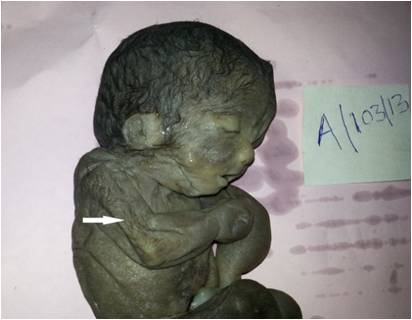Non-Immune Hydrops Foetalis due to Congenital Toxoplasmosis: a rare case report with review of literature.
Keywords:
Non-Immune Hydrops Foetalis, toxoplasmosis, hypoplastic lungs
Abstract
Non-Immune Hydrops Foetalis (NIHF) implies an excess of total body water which manifests as extracellular accumulation of fluid in serous cavities and soft tissues of foetus without any detectable circulating antibody against RBC antigen. Toxoplasmosis is an important congenitally acquired infectious cause of NIHF.Mother had complaints of fever, reduced foetal movements, USG showed hydrops foetalis and she tested positive for Toxoplasma IgG antibodies. On autopsy, foetus had generalised subcutaneous oedema, bilateral hypoplastic lungs with pleural effusion and oedema of brain with ventriculomegaly suggestive of hydrocephalus. We report a rare case of NIHF due to congenital toxoplasmosis with bilateral hypoplastic lungs, with emphasis on epidemiology and prevention of toxoplasmosis. DOI: 10.21276/APALM.1077References
1) Trainor B, Tubman R. The Emerging Pattern of Hydrops Fetalis - Incidence, aetiology and management. Ulster Med J 2006;75(3):185–6.
2) Nagaraja B, Ramana BV, Murty DS, Naidu K, Reddy Kailasanatha B. Prevalence of Toxoplasmosis among Antenatal Women with Bad Obstetric History. IJPRBS, 2012;1(3):222–7.
3) Torgerson PR, Mastroiacovo P. The global burden of congenital toxoplasmosis: a systematic review. Bull World Health Organ 2013;91:501-8.
4) Norton ME, Chauhan SP, Dashe JS. Society for Maternal-Fetal Medicine(SMFM) Clinical Guideline #7 : Nonimmune hydrops fetalis. Am J Obstet Gynecol 2015.;127-133.
5) Mascaretti RS, Falcão MS , Silva AM, Costa Vaz FA, Leone CR. Characterization of newborns with Nonimmune Hydrops Fetalis admitted to a Neonatal Intensive Care Unit. Rev. Hosp. Clín. Fac. Med. S. Paulo 2003;58(3):125-132.
6) Jones JL, Lopez A,Wilson M, Schulkin J, Gibbs R. Congenital toxoplasmosis: a review. Obstet Gynecol Surv 2001;56(5):296-305.
7) Singh S, Munawwar A, Rao S, Mehta S, Hazarika NK. Serologic Prevalence of Toxoplasma gondii in Indian Women of Child Bearing Age and Effects of Social and Environmental Factors. PLoS Negl Trop Dis 2014;8(3):e2737.
8) Singh S, Singh N. Toxoplasmosis is sexually transmitted. Proceeding of IX International Conference on AIDS. Berlin, Germany. 1993; 6–11.
9) Palanisamy M, Madhavan B, Balasundaram MB, Andavar R, Venkatapathy N. Outbreak of ocular toxoplasmosis in Coimbatore, India. Indian J Ophthalmol 2006;54:129-31.
10) Serranti D, Buonsenso D, Valentini P. Congenital toxoplasmosis treatment. Eur Rev for Med Pharmacol Sci 2011;15:193-8.
11) Mittal V, Ichhpujani RL. Toxoplasmosis – An Update. Trop Parasitol 2011; 1(1):9–14.
12) Dubey JP, Beattie CP. Toxoplasmosis of animals and man. Boca Raton, FL: CRC Press, Chapter 1.General Biology: Section V, Epidemiology and Epizootiology. 1988, pp 24.
13) Giannoulis C, Zournatzi B, Giomisi A, Diza E, Tzafettas I. Toxoplasmosis during pregnancy: a case report and review of the literature. Hippokratia 2008;12(3):139–143.
14) Paquet C, Yudin M.H. Toxoplasmosis in Pregnancy: Prevention, Screening and Treatment. J Obstet Gynaecol Can 2013;35:S1–S7.
15) Iqbal J, Khalid N. Detection of acute Toxoplasma gondii infection in early pregnancy by IgG avidity and PCR analysis. J.Med.Microbiol 2007;(56):1495–9.
2) Nagaraja B, Ramana BV, Murty DS, Naidu K, Reddy Kailasanatha B. Prevalence of Toxoplasmosis among Antenatal Women with Bad Obstetric History. IJPRBS, 2012;1(3):222–7.
3) Torgerson PR, Mastroiacovo P. The global burden of congenital toxoplasmosis: a systematic review. Bull World Health Organ 2013;91:501-8.
4) Norton ME, Chauhan SP, Dashe JS. Society for Maternal-Fetal Medicine(SMFM) Clinical Guideline #7 : Nonimmune hydrops fetalis. Am J Obstet Gynecol 2015.;127-133.
5) Mascaretti RS, Falcão MS , Silva AM, Costa Vaz FA, Leone CR. Characterization of newborns with Nonimmune Hydrops Fetalis admitted to a Neonatal Intensive Care Unit. Rev. Hosp. Clín. Fac. Med. S. Paulo 2003;58(3):125-132.
6) Jones JL, Lopez A,Wilson M, Schulkin J, Gibbs R. Congenital toxoplasmosis: a review. Obstet Gynecol Surv 2001;56(5):296-305.
7) Singh S, Munawwar A, Rao S, Mehta S, Hazarika NK. Serologic Prevalence of Toxoplasma gondii in Indian Women of Child Bearing Age and Effects of Social and Environmental Factors. PLoS Negl Trop Dis 2014;8(3):e2737.
8) Singh S, Singh N. Toxoplasmosis is sexually transmitted. Proceeding of IX International Conference on AIDS. Berlin, Germany. 1993; 6–11.
9) Palanisamy M, Madhavan B, Balasundaram MB, Andavar R, Venkatapathy N. Outbreak of ocular toxoplasmosis in Coimbatore, India. Indian J Ophthalmol 2006;54:129-31.
10) Serranti D, Buonsenso D, Valentini P. Congenital toxoplasmosis treatment. Eur Rev for Med Pharmacol Sci 2011;15:193-8.
11) Mittal V, Ichhpujani RL. Toxoplasmosis – An Update. Trop Parasitol 2011; 1(1):9–14.
12) Dubey JP, Beattie CP. Toxoplasmosis of animals and man. Boca Raton, FL: CRC Press, Chapter 1.General Biology: Section V, Epidemiology and Epizootiology. 1988, pp 24.
13) Giannoulis C, Zournatzi B, Giomisi A, Diza E, Tzafettas I. Toxoplasmosis during pregnancy: a case report and review of the literature. Hippokratia 2008;12(3):139–143.
14) Paquet C, Yudin M.H. Toxoplasmosis in Pregnancy: Prevention, Screening and Treatment. J Obstet Gynaecol Can 2013;35:S1–S7.
15) Iqbal J, Khalid N. Detection of acute Toxoplasma gondii infection in early pregnancy by IgG avidity and PCR analysis. J.Med.Microbiol 2007;(56):1495–9.

Published
2017-03-28
Issue
Section
Case Report
Authors who publish with this journal agree to the following terms:
- Authors retain copyright and grant the journal right of first publication with the work simultaneously licensed under a Creative Commons Attribution License that allows others to share the work with an acknowledgement of the work's authorship and initial publication in this journal.
- Authors are able to enter into separate, additional contractual arrangements for the non-exclusive distribution of the journal's published version of the work (e.g., post it to an institutional repository or publish it in a book), with an acknowledgement of its initial publication in this journal.
- Authors are permitted and encouraged to post their work online (e.g., in institutional repositories or on their website) prior to and during the submission process, as it can lead to productive exchanges, as well as earlier and greater citation of published work (See The Effect of Open Access at http://opcit.eprints.org/oacitation-biblio.html).




